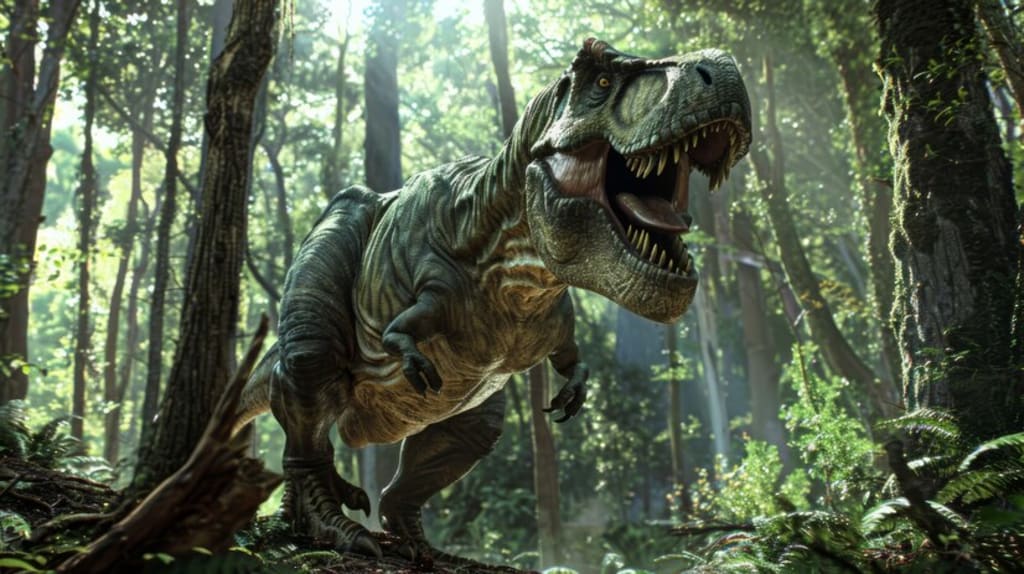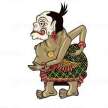"Tyrannosaurus Rex: Unraveling the Mysteries of the Ultimate Predator"
the creature Tyrannosaurus rex and life in its time

The Tyrannosaurus Rex, often abbreviated as T-Rex, is one of the most iconic dinosaurs that roamed the Earth during the Late Cretaceous period, around 68 to 66 million years ago. Here are some fascinating facts about this majestic creature:
1. **Size and Appearance**: T-Rex was one of the largest carnivorous dinosaurs, reaching lengths of up to 40 feet (12 meters) and standing about 15 to 20 feet (4.6 to 6 meters) tall. It weighed between 7 and 9 tons. It had a massive skull, filled with teeth up to 12 inches (30 cm) long, designed for crushing bones and tearing flesh.
2. **Diet**: Despite its fearsome reputation, T-Rex was likely a scavenger as well as a hunter. Its diet primarily consisted of other dinosaurs, including herbivores like Triceratops and Edmontosaurus.
3. **Habitat**: Fossils of T-Rex have been found in what is now western North America, particularly in Montana, South Dakota, Wyoming, and Alberta, Canada. It lived in a variety of environments, including forests, floodplains, and coastal regions.
4. **Speed and Agility**: Despite its massive size, T-Rex was surprisingly fast and agile. It could run at speeds of up to 25 miles per hour (40 km/h), allowing it to chase down prey or scavenge over large distances.
5. **Extinction**: Like all non-avian dinosaurs, T-Rex went extinct around 66 million years ago, likely as a result of the catastrophic event that led to the end of the Mesozoic Era, possibly a combination of volcanic activity, asteroid impact, and climate change.
6. **Discovery and Name**: T-Rex was first discovered in 1902 by paleontologist Barnum Brown in Montana, USA. Its name, Tyrannosaurus Rex, means "Tyrant Lizard King" in Greek, reflecting its powerful and imposing stature.
7. **Behavior**: While much of T-Rex's behavior remains speculative, scientists believe it may have been a solitary animal, except during mating or when caring for its young.
8. **Pop Culture**: T-Rex has become a cultural icon, appearing in numerous movies, books, and TV shows. It is often depicted as the ultimate apex predator, inspiring both awe and terror in the imaginations of people around the world.
9. **Anatomy and Physiology**: T-Rex had a unique anatomy that contributed to its dominance as a predator. Its large head was supported by a robust neck, allowing it to deliver powerful bites. Its arms, though small compared to its body size, were incredibly strong and ended in two-fingered hands, possibly used for grasping prey or aiding in mating rituals. Despite its small arms, T-Rex had a massive tail that helped with balance and agility.
10. **Teeth and Bite Force**: T-Rex had some of the most formidable teeth of any dinosaur. Its teeth were serrated and banana-shaped, ideal for slicing through flesh and crushing bones. Studies estimate that T-Rex could exert a bite force of up to 8,000 pounds-force (35,000 newtons), making it one of the most powerful biters in the animal kingdom.
11. **Growth and Development**: Like modern reptiles, T-Rex likely grew throughout its life but at a slower rate compared to mammals. Juvenile T-Rex specimens show distinct differences in bone structure compared to adults, suggesting changes in diet and behavior as they matured. It's believed that T-Rex reached sexual maturity at around 14 to 18 years of age.
12. **Senses and Intelligence**: While much of T-Rex's behavior is speculative, scientists believe it had keen senses, including sharp vision and a highly developed sense of smell. Its large olfactory bulbs indicate a strong sense of smell, which would have been crucial for locating prey or scavenging opportunities. In terms of intelligence, T-Rex likely had a relatively large brain compared to other dinosaurs, although it's unclear how intelligent it was compared to modern animals.
13. **Feathers or Scales**: There is ongoing debate among paleontologists about whether T-Rex had feathers, scales, or a combination of both. Fossil evidence suggests that juvenile T-Rex may have had feathers or feather-like structures, but adult T-Rex specimens show evidence of scales. It's possible that T-Rex underwent changes in its integumentary covering as it matured, similar to some modern birds and reptiles.
14. **Social Behavior**: The social behavior of T-Rex is still a subject of speculation. While it was likely a solitary hunter for much of its life, some evidence suggests that it may have engaged in social behaviors, particularly during mating seasons or when caring for its young. Fossil evidence of multiple T-Rex individuals found in close proximity raises the possibility of pack behavior or familial groups.
15. **Evolutionary Significance**: As one of the last and largest non-avian dinosaurs, T-Rex holds significant evolutionary importance. Its extinction marked the end of the Mesozoic Era and the dominance of dinosaurs on Earth. Studying T-Rex and its relatives provides valuable insights into the evolution and ecology of dinosaurs and their role in prehistoric ecosystems.
Tyrannosaurus Rex continues to captivate the imagination of scientists and enthusiasts alike, inspiring ongoing research and exploration into the mysteries of the prehistoric world.
About the Creator
Sugi harto
reading and writing opens up world views
Enjoyed the story? Support the Creator.
Subscribe for free to receive all their stories in your feed. You could also pledge your support or give them a one-off tip, letting them know you appreciate their work.






Comments
There are no comments for this story
Be the first to respond and start the conversation.